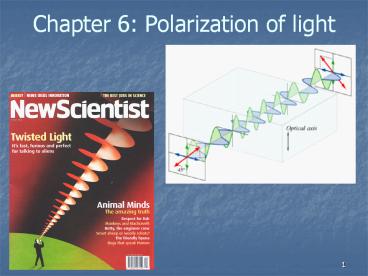Chapter 6: Polarization of light PowerPoint PPT Presentation
1 / 22
Title: Chapter 6: Polarization of light
1
Chapter 6 Polarization of light
2
First, review the chapter onAtomic Structure
- The elements
3
- Preliminaries and definitions
- Plane-wave approximation E(r,t) and B(r,t) are
uniform in the plane ? k - We will say that light polarization vector is
along E(r,t) (although it was along B(r,t) in
classic optics literature) - Similarly, polarization plane contains E(r,t) and
k
4
Simple polarization states
- Linear or plane polarization
- Circular polarization
- Which one is LCP, and which is RCP ?
Electric-field vector is seen rotating
counterclockwise by an observer getting hit in
their eye by the light (do not try this with
lasers !)
Electric-field vector is seen rotating clockwise
by the said observer
5
Simple polarization states
- Which one is LCP, and which is RCP?
- Warning optics definition is opposite to that in
high-energy physics helicity - There are many helpful resources available on the
web, including spectacular animations of various
polarization states, e.g., http//www.enzim.hu/sz
ia/cddemo/edemo0.htm
Go to Polarization Tutorial
6
More definitions
- LCP and RCP are defined w/o reference to a
particular quantization axis - Suppose we define a z-axis
- ?-polarization linear along z
- ? LCP (!) light propagating along z
- ?- RCP (!) light propagating along z
If, instead of light, we had a right-handed wood
screw, it would move opposite to the light
propagation direction
7
Elliptically polarized light
- a semi-major axis b semi-major axis
8
Unpolarized light ?
- Is similar to free lunch in that such thing,
strictly speaking, does not exist - Need to talk about non-monochromatic light
- The three-independent light-source model (all
three sources have equal average intensity, and
emit three orthogonal polarizations - Anisotropic light (a light beam) cannot be
unpolarized !
9
Angular momentum carried by light
- The simplest description is in the photon picture
- A photon is a particle with intrinsic angular
momentum one ( ) - Orbital angular momentum
- Orbital angular momentum and Laguerre-Gaussian
Modes (theory and experiment)
10
Helical Light Wavefronts
11
Formal description of light polarization
- The spherical basis
- e1 ? LCP for light propagating along z
Lagging by ?/2
? LCP
12
Decomposition of an arbitrary vector E into
spherical unit vectors
Recipe for finding how much of a given basic
polarization is contained in the field E
13
Polarization density matrix
For light propagating along z
- Diagonal elements intensities of light with
corresponding polarizations - Off-diagonal elements correlations
- Hermitian
- Unit trace
- ? We will be mostly using normalized DM where
this factor is divided out
14
Polarization density matrix
- DM is useful because it allows one to describe
unpolarized
- and partially polarized light
- Theorem Pure polarization state ? ?2?
- Examples
- Unpolarized Pure circular polarization
15
Visualization of polarization
- Treat light as spin-one particles
- Choose a spatial direction (?,f)
- Plot the probability of measuring
spin-projection 1 on this direction
? Angular-momentum probability surface
- Examples
- z-polarized light
16
Visualization of polarization
- Examples
- circularly polarized light propagating along z
17
Visualization of polarization
- Examples
- LCP light propagating along ??/6 f ?/3
- Need to rotate the DM details are given, for
example, in
? Result
18
Visualization of polarization
- Examples
- LCP light propagating along ??/6 f ?/3
19
Description of polarization with Stokes parameters
- P0 I Ix Iy Total intensity
- P1 Ix Iy Lin. pol. x-y
- P2 I?/4 I- ?/4 Lin. pol. ? ?/4
- P3 I I- Circular pol.
Another closely related representation is the
Poincaré Sphere
See http//www.ipr.res.in/othdiag/zeeman/poincare
2.htm
20
Description of polarization with Stokes
parameters and Poincaré Sphere
- P0 I Ix Iy Total intensity
- P1 Ix Iy Lin. pol. x-y
- P2 I?/4 I- ?/4 Lin. pol. ? ?/4
- P3 I I- Circular pol.
- Cartesian coordinates on the Poincaré Sphere are
normalized Stokes parameters
P1/P0, P2/P0 , P3/P0 - With some trigonometry, one can see that a state
of arbitrary polarization is represented by a
point on the Poincaré Sphere of unit radius - Partially polarized light ? Rlt1
- R degree of polarization
21
Jones Calculus
- Consider polarized light propagating along z
- This can be represented as a column (Jones)
vector - Linear optical elements ? 2?2 operators (Jones
matrices), for example - If the axis of an element is rotated, apply
22
Jones Calculus an example
- x-polarized light passes through quarter-wave
plate whose axis is at 45? to x - Initial Jones vector
- The Jones matrix for the rotated wave plate is
- Ignore overall phase factor ?
- After the plate, we have
- Or
- expected circular polarization

